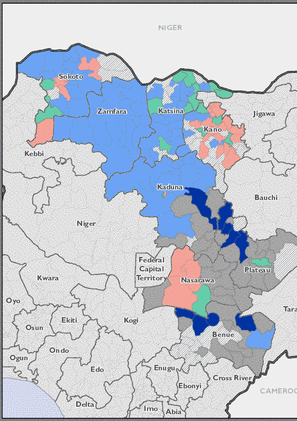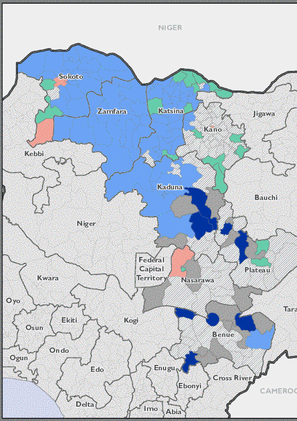-
Countries
-
Data and Analysis
-
Special Focus
-
Crisis Responses

Contact
DTM Nigeria, iomnigeriadtm@iom.int
Language
English
Location
Nigeria
Period Covered
Dec 08 2023
Dec 30 2023
Activity
- Mobility Tracking
- Baseline Assessment
As of December 2023, DTM identified a total of 1,092,196 internally displaced persons (IDPs) in 183,437 households across Benue, Kaduna, Kano, Katsina, Nasarawa, Plateau, Sokoto, and Zamfara states. The data collection started in December 2023 in 1,646 locations, in the eight states of north-central and north-west Nigeria. The IDP population included IDPs in camps and camp-like settings (196,502 individuals or 18%) and IDPs residing in host communities (895,694 individuals or 82%). This signifies an IDP increase of 1.5 per cent or 16,303 IDPs compared to what it was in September 2023.

Contact
IOMDTMPoland@iom.int
Language
English
Location
Poland
Period Covered
Jan 01 2023
Dec 31 2023
Activity
- Survey
Key Findings:
- Among respondents, 46 per cent spent more than one year in displacement. 20 per cent of respondents had spent less than a month in displacement at the time of the interview.
- The majority of respondents (57%) were travelling back to Ukraine alone. The remaining 43 per cent of survey respondents were crossing back into Ukraine as part of a group. 95 per cent of respondents travelling with a group (N=1,998) were travelling with their immediate family
- Out of 4,650 respondents, 86 per cent were planning to return to the same oblast of origin while the remaining 14 per cent aimed to reach a different one. Out of those returning to a different oblast (N=667), 16 per cent were originally from Donetska oblast, 14 per cent from Dnipropetrovska, 13 per cent from Zaporizka, and 12 per cent from Kyiv city.
- The percentage of respondents that had been residing in Poland prior to crossing back to Ukraine decreased steadily from 59 per cent in the first quarter of 2023 to 46 per cent in the fourth quarter (overall 50%).
- Overall, the top four most frequently indicated reasons for returning to Ukraine for the long-term were missing home (52%), reuniting with family (20%), working in essential services (16%), and because they had been visiting someone abroad but reside in Ukraine (15%).
- The proportion of respondents that reported having experienced discrimination has steadily risen from seven per cent in the first quarter to 18 per cent in the fourth quarter.
- Of respondents who received humanitarian assistance, the most frequently reported type was financial support (86%), for which the percentage has increased throughout the quarters of 2023.
Year of displacement
Number of IDPs by LGA
Reasons for displacement by State
Reasons for displacement by LGA - before 2021
Reasons for displacement by LGA - 2021
Reasons for displacement by LGA - 2022
Contact
DTMDRC@iom.int
Location
Democratic Republic of the Congo
Activity
- Mobility Tracking
- Baseline Assessment
Period Covered
Nov 20 2023 -Dec 15 2023
Since the start of the crisis, IOM, through the DTM continues to conduct a series of rapid assessments, including emergency monitoring (EET/ERM), crisis analysis and recording with priority to respond to immediate information needs to understand travel dynamics and needs. This report presents the results of assessments carried out in the different areas of displacement and return from November 20 to December 15, 2023.
Population Groups
IDPs
Returnee (Previously Internally Displaced)
Survey Methodology
Unit of Analysis Or Observation
Admin Area 2
Admin Area 3
Admin Area 4
Type of Survey or Assessment
Key Informant
Keywords
Geographical Scope Partial Coverage
Administrative boundaries with available data
The current dataset covers the following administrative boundaries
Reasons for displacement by LGA - 2023







